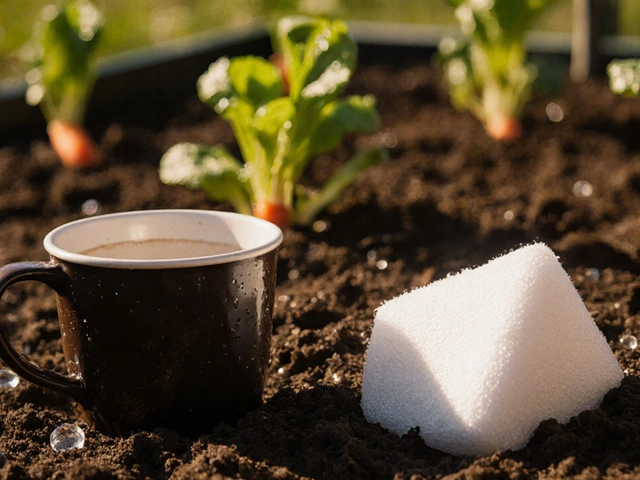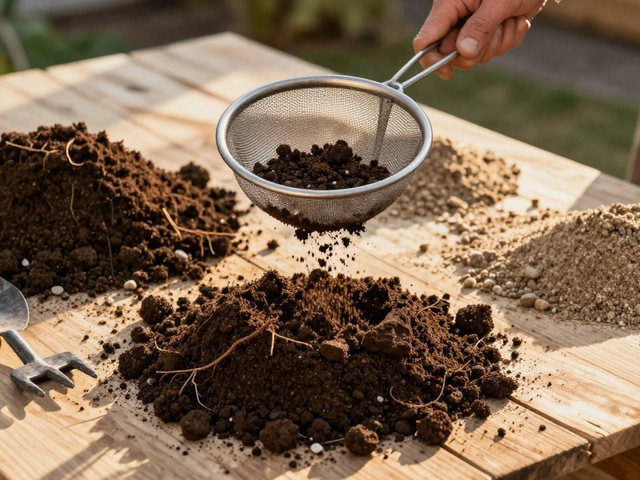Some questions in gardening pop up so often they almost become a rite of passage – like, is vermiculite better than perlite for my soil? Honestly, there’s no instant “one is always better” answer because these two materials are both rockstars in their own way. Lots of folks mix them up since they both come as little white or gold specks that fluff up potting soil, but they don’t do the same thing.
Vermiculite and perlite change how soil drains and holds water, which can make the difference between plump tomatoes or wilted lettuce in July. Ever had seedlings that dry out if you miss a day's watering? Or roots that drown after a thunderstorm? That’s where these soil tweaks come in. If you're hoping for a garden that survives your vacation or a heatwave, understanding what these two additives actually do is pretty important. I’ve got hands-on experience with both, so let’s break down what makes each one tick—and when to grab the right bag.
- What Are Vermiculite and Perlite?
- How Each Improves Garden Soil
- Real-Life Pros and Cons
- Choosing the Right One for Your Plants
- Tips and Surprising Uses
What Are Vermiculite and Perlite?
Ever wondered what those tiny, crumbly bits in your potting mix actually are? Let’s break down the basics of vermiculite and perlite so you really get what’s in the bag.
Vermiculite comes from heat-treated, flaky minerals—imagine little accordions that puff up and trap water. It feels soft and a bit spongy, almost like a tiny, golden-brown version of popcorn. On the other hand, perlite is made from heated volcanic glass that pops at high temperatures, blowing up into bright white, porous chips. Think of it as the Styrofoam of the gardening world, only much better for plants and completely natural.
Both are used to boost soil structure, but they each act a bit differently once you add them to your beds or pots. Here’s a quick comparison to clear things up:
| Feature | Vermiculite | Perlite |
|---|---|---|
| Texture | Soft, spongy, tan/gold | Crunchy, light, white |
| Source | Heat-expanded mica | Heated volcanic glass |
| Water retention | High | Low |
| Drainage | Moderate | Excellent |
| pH | Almost neutral (7.0) | Neutral to slightly alkaline |
These two aren’t fertilizers—they don’t feed your plants directly. Instead, they help balance how much air and water your soil holds, which almost always means stronger roots. It's also good to know that vermiculite is great at soaking up nutrients from fertilizer water and hanging on to them for longer, while perlite keeps things airy so roots don’t suffocate. Their different qualities matter a lot depending on what you’re growing or how forgetful you are about watering!
How Each Improves Garden Soil
Both vermiculite and perlite play different roles in garden soil, even though they seem similar. If you scoop up a handful of potting mix and see those white bits, that’s usually perlite. The gold or silvery flakes are probably vermiculite. But these differences aren’t just about looks—they affect how your plants grow.
Vermiculite comes from heated mica rock. It soaks up water like a sponge and slowly releases it back as the soil dries. If you have plants that like to stay evenly moist—think ferns, African violets, or most seedlings—vermiculite helps stop their roots from drying out so fast. It also binds onto nutrients, so fertilizers stick around longer for your plants to use.
Perlite, on the other hand, is made from “popped” volcanic glass. It’s super light and airy; water runs through it fast. This means it keeps soil from getting compacted and soggy, which is perfect for stuff like cacti, succulents, and herbs that hate "wet feet." You’ll notice pots with perlite dry out faster (sometimes even in just a day during summer).
If you’re wondering how much these improve the soil, check out this quick comparison:
| Feature | Vermiculite | Perlite |
|---|---|---|
| Water Holding Capacity | High – holds 200-300% its weight | Low – holds 20-50% its weight |
| Boosts Drainage | Some (keeps soil moist longer) | Yes (makes soil fast-draining) |
| Helps Aeration | Some, but less than perlite | Excellent |
| pH | Just slightly alkaline | Near neutral (6.6 - 7.5) |
| Nutrient Exchange | Good | Low |
What does this mean for you? Use vermiculite when you want garden soil improvement for moisture-loving plants. Grab perlite when you’re worried about root rot or heavy clay soils that stay soggy. Everyone’s climate and plant choice are a little different, but understanding these two lets you tweak your soil for real results instead of just guessing.

Real-Life Pros and Cons
So what really happens when you toss vermiculite or perlite into your soil or seedling tray? Here’s what you actually notice, not just what the bag claims.
The most obvious difference is with water. Vermiculite soaks up moisture like a sponge and slowly releases it, which means your soil stays damp longer. This is a lifesaver if you forget to water or are starting seeds that hate to dry out. Perlite, on the other hand, is all about drainage. It's much lighter and rougher, letting water pass through fast and keeping roots from sitting in a puddle. Makes overwatering way less risky.
But there’s more to it than just wet or dry. Vermiculite also hangs onto nutrients like potassium and magnesium, helping root systems get what they need. Perlite doesn’t do that as much—it’s just there to make pockets of air. That means perlite is killer for plants that like things airy (think cactus or succulents). Vermiculite’s better if you’re dealing with thirsty seedlings or things that wilt fast, like ferns or mint.
| Feature | Vermiculite | Perlite |
|---|---|---|
| Water Retention | Holds up to 4x its weight | Drains quickly, holds little water |
| Best For | Seed starting, moisture-loving plants | Succulents, cacti, heavy clay soils |
| pH Level | Neutral to slightly alkaline | Generally neutral |
| Nutrient Holding | Absorbs and releases nutrients | No real nutrient storage |
| Price (Avg. per cubic ft.) | $6–$10 | $4–$7 |
Here are some real-life pros and cons for each:
- Vermiculite pros: Stays moist longer, great for seed starting, doesn't break down quickly so you don’t need to replace often.
- Vermiculite cons: Can make soil mushy if you use too much, and in very humid spots, it might encourage fungus or gnats.
- Perlite pros: Super for fixing heavy, sticky soils; cheap and lightweight; almost impossible to overdo, so good for beginners.
- Perlite cons: Can get dusty (wear a mask while mixing), and since it floats, you might see bits rise to the surface after you water.
I learned this the hard way when Aaron once got creative and filled a whole pot with only perlite. The plant dried out quicker than toast. Same problem, just flipped, if you load up a tray with straight vermiculite—roots can almost suffocate. Getting the mix right is what really makes the magic happen.
Choosing the Right One for Your Plants
You can’t just toss in any soil additive and hope for great results. Let’s get specific—different plants have different needs, and that’s where perlite and vermiculite start to shine in their own ways.
If you’re growing cacti, succulents, or anything that HATES soggy roots, you want soil that drains fast. Perlite is your go-to here, because those little white puffs help water whoosh right through, keeping roots dry and happy. I swap in perlite when I’m potting up aloe or jade, and honestly, it’s a game changer for not having mushy roots.
Now, look at veggies or indoor plants like lettuce, ferns, or African violets. These ones like staying a little more damp, especially during summer spikes or if you forget to water (like I do when Aaron drags me off for a weekend hike). Vermiculite stores water and releases it slowly, so your plants can sip what they need between waterings.
- Use perlite for: cacti, succulents, bonsai, seed starting mixes where quick drainage is key.
- Use vermiculite for: seedlings that need steady moisture, moisture-loving houseplants, and situations where you’re worried about soil drying out too quick.
Here’s a super helpful way to compare their key uses side by side:
| Soil Additive | Best For | Water Retention | Drainage |
|---|---|---|---|
| Perlite | Succulents, cacti, cuttings | Low | Excellent |
| Vermiculite | Seedlings, most veggies, indoor plants | High | Good (but holds more water) |
If your plant roots keep rotting, swap in more perlite. When seedlings dry up too fast, boost the vermiculite. Don’t feel weird about doing a little mix-and-match—many gardeners (including me) blend both in soil for just the right balance.

Tips and Surprising Uses
If you thought vermiculite and perlite were just for fluffing up garden soil, you’re missing out. These simple minerals have loads of handy uses that can make everyday plant care easier and maybe even save you a little money. Here’s how to make the most of what’s in those bags.
- Vermiculite is awesome for starting seeds. Its moisture-holding superpower creates a gentle, damp environment that helps even fussy seeds sprout faster. Sprinkle a thin layer over sown seeds in trays and notice how evenly things pop up—even basil, which is notorious for patchy germination.
- If you repot houseplants and want less mess or fewer fungus gnats, mix perlite into the potting mix. It keeps the soil from packing down, which means roots get more air and grow faster. Plus, fungus gnats hate perlite because it dries out the top layer and ruins their party.
- Worried about storing bulbs through winter? Vermiculite can help. Store your dormant bulbs, like dahlias or gladiolus, in a box layered with dry vermiculite. It keeps rot away by gently controlling humidity—no more mushy bulbs in spring.
- If you ever catch yourself overwatering, toss a handful of perlite at the bottom of pots. Think of it as cheap insurance so roots don’t sit in soggy soil and rot.
- Trying your hand at hydroponics or propagating cuttings in water? Perlite can prop up those stems, keeping them upright and cutting down on mold compared to using regular waterlogged soil. Just plant cuttings in a cup of perlite and keep the bottom half damp.
- For compost bins that get too wet, adding vermiculite helps balance moisture. It soaks up excess water so you don’t end up with a smelly, slimy mess.
- On hot days, adding perlite to garden beds can cut surface temperature and keep roots cooler. One study showed soil mixed with 20% perlite was up to 5°F cooler in direct sun than regular soil.
Here’s a quick look at what each is best for:
| Use | Vermiculite | Perlite |
|---|---|---|
| Seed starting | Best | Works |
| Improving drainage | Okay | Best |
| Bulb storage | Best | No |
| Fungal prevention | Okay | Best |
| Compost moisture control | Best | Not ideal |
| Hydroponics | Not used | Best |
The trick is knowing when to reach for the right bag rather than feeling like you need both for every project. You rarely need more than a 20% mix of either for most potting needs.




